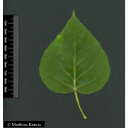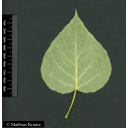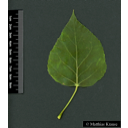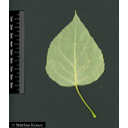Useful information about the taxon (species, subspecies, variety...)
Populus balsamifera L. 1753
Salicaceae
(APG IV)balsam poplar, heartleaf balsam poplar, cottonwood, bam, tacamahac
Taxon concept: The Plant List (2014), version 1.1
Distribution: Canada, USA: Alaska, northeastern to northwestern, Rocky Mountains
Populus balsamifera L. - Accepted: Populus balsamifera L. bei The Plant List (2014), version 1.1; Familie: Salicaceae (APG III)Populus balsamifera L. - Accepted: Populus balsamifera L. bei BfN Checklist Flora DE; Familie: Salicaceae (APG IV)
- Flowers
- dioecious tree; flowers in drooping catkins
- Flower ecology
- wind-pollinated (anemophilous)
- Life form
- woody; tree
- Foliage persistence
- deciduous
- Fruits
- dull green capsule fruit contains numerous seeds
- Fruit ecology
- wind-dispersed (anemochorous), on floodplain sites also water-dispersed (hydrochorous)
- Soil conditions
- preferentially on moist sea and river sediments and on gravel, clay loam, silty loam soils
- Root type
- shallow roots
- Succession type
- pioneer species
- Natural occurrence (habitat)
- stream banks, river floodplains, mixed forests, spruce forests, red spruce (Picea rubens)-balsam fir (Abies balsamea) forests, boreal swamps (with northern white-cedar [Thuja occidentalis), moist depressions, borrow pits, mixed deciduous forests (ash-elm-maple-forests)
- Vegetation typ and synecology (plant community)
- mesophytic boreal and montane forests
- Constraints according radiation (light)
- low shade tolerance
- Usage
- wood is used for pulp and construction, for veneer and particle boards
- Phytopathogenic organisms
- is affected by the poplar and willow wood borer (Cryptorhynchus lapathi), the bronze poplar borer (Agrilus liargus), and the poplar borer (Saperda calcarata)
- Bark
- smooth, light grey to greyish brown bark
Botanical Society of the British Isles and the Biological Records Centre (2012): Online Atlas of the British and Irish Flora. See: http://www.brc.ac.uk/plantatlas/; Erhardt, W., Götz, E., Bödeker, N. & Seybold, S. (2008): Der große Zander. Enzyklopädie der Pflanzennamen. Band 2. Arten und Sorten. Eugen Ulmer KG, Stuttgart (Hohenheim), 18. Aufl., 2103 S.; Nesom, G. (2006): USDA Plant Guide: Red Maple. See: https://plants.usda.gov/plantguide/pdf/pg_acru.pdf; The International Plant Names Index (2009). Published on the Internet http://www.ipni.org; Courtesy to IPNI, 2009. Exported from IPNI at date: 2009-09-22 20:17:51;
Diese Webseite verwendet Google Maps, um Karten und Standorte von Pflanzen in den Hohenheimer Gärten anzuzeigen. Dadurch werden unter Umständen Daten an Google weitergeleitet, was mit einer Verarbeitung Ihrer personenbezogenen Daten verbunden sein kann. Die Datenschutzerklärung von Google finden Sie hier: Datenschutzerklärung von Google
| Sex | Standort | Accession number | Planting year | Donation | IPEN | Lat. | Long. |
|---|




